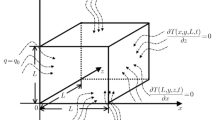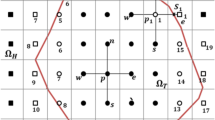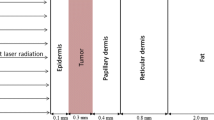Abstract
This paper presents a computational strategy for real-time monitoring of hyperthermia treatment of cancer using nanoparticles. In this strategy, a numerical scheme based on the finite volume method is used for the simulation of heat diffusion in a synthetic biological system. This synthetic model is discretized with OcTree meshes, which can perform local refinement, allowing a good representation of complex geometries, besides having advantages on the use of computational resources. For real-time estimation of temperature in the three-dimensional model, the capture of the temperature field on the external surface of the model is simulated. With the data from these simulations, inverse problems are proposed and solved using the L-BFGS method. The damage caused by a temperature increase in healthy and diseased tissues is estimated, thus simulating a criterion for treatment safety. Numerical examples are analyzed with tumors at different depths, illustrating some particularities of this approach.







Similar content being viewed by others
Abbreviations
- A :
-
Empirical constant used in damage simulation, \(\hbox {s}^{-1}\)
- c :
-
Specific heat, J/\(\hbox {Kg}^{\circ }\mathrm{C}\)
- \(c_b\) :
-
Specific heat of the blood, J/\(\hbox {Kg}^{\circ }\mathrm{C}\)
- E :
-
Activation energy for the reaction, J/mol
- \(F_j\) :
-
Face of a control volume
- h :
-
Grid spacing, m
- \(n_f\) :
-
Number of faces
- \(n_v\) :
-
Number of volumes
- \(Q_m\) :
-
Metabolic heat generation, W/\(\hbox {m}^3\)
- \(Q_r\) :
-
Internal heat energy emerged from the nanoparticles, W/\(\hbox {m}^3\)
- R :
-
Universal gas constant, J/\(\hbox {mol}^{\circ }\mathrm{C}\)
- \({\mathbf {R}}\) :
-
Real numbers set
- \(S_i\) :
-
Control volume surface
- \(V_i\) :
-
Control volume
- \(W_b\) :
-
Blood perfusion rate, Kg/s/\(\hbox {m}^3\)
- \(W_b^*\) :
-
Weighted average of the nonlinear perfusion, Kg/s/\(\hbox {m}^3\)
- \(\kappa \) :
-
Thermal conductivity, W/\(\hbox {m}^{\circ }\mathrm{C}\)
- \(\rho \) :
-
Density, Kg/\(\hbox {m}^3\)
- \(\phi _a\) :
-
Arterial temperature, \(^{\circ }\mathrm{C}\)
- \(\phi \) :
-
Tissue temperature, \(^{\circ }\mathrm{C}\)
- \(\Delta t\) :
-
Time increment, s
- \(\Omega \) :
-
Tissue damage
- \(\chi \) :
-
Concentration of nanoparticles in a biological environment
- \(\mathbf {U_o}\) :
-
Temperature values observed on the skin surface
- \(\mathbf {U_s}\) :
-
Temperature values obtained with the computational simulation
- \({\mathbf {F}}\) :
-
Residue function
References
Minkowycz W, Sparrow EM, Abraham JP (2012) Nanoparticle heat transfer and fluid flow. CRC Press, Boca Raton
Huang S, Hainfeld J (2013) Intravenous magnetic nanoparticle cancer hyperthermia. Int J Nanomed 2521–2532
Hervault A, Thanh NTK (2014) Magnetic nanoparticle-based therapeutic agents for thermo-chemotherapy treatment of cancer. Nanoscale 6(20):11553–11573. https://doi.org/10.1039/c4nr03482a
Jha S, Sharma PK, Malviya R (2016) Hyperthermia: role and risk factor for cancer treatment. Achiev Life Sci. https://doi.org/10.1016/j.als.2016.11.004
Zienkiewicz OC, Morgan K (1983) Finite element and approximation. John Wiley Edition
Barth TJ (1992) Aspects of unstructured grids and finite-volume solvers for the Euler and Navier–Stokes equations, agard repo Edition
Popinet S (2003) Gerris: a tree-based adaptive solver for the incompressible Euler equations in complex geometries. J Comput Phys 190(2):572–600
Haber E, Heldmann S (2007) An octree multigrid method for quasi-static Maxwell’s equations with highly discontinuous coefficients. J Comput Phys 223(2):783–796
Horesh L, Haber E (2011) A second order discretization of maxwell’s equations in the quasi-static regime on octree grids. SIAM J Sci Comput 33(5):2805–2822
Valente AG, Di Bartolo L, Mansur WJ (2015) 3D seismic modeling using staggered-grid OcTree mesh. In: SEG Technical Program Expanded Abstracts 2015, pp 3754–3758
Valente A, Loureiro F, Di Bartolo L, Mansur WJ (2018) Computer simulation of hyperthermia with nanoparticles using an OcTree finite volume technique. Int Commun Heat Mass Transf 91:248–255. https://doi.org/10.1016/j.icheatmasstransfer.2017.12.021
Liu DC, Nocedal J (1989) On the limited memory BFGS method for large scale optimization. Math Program 45:503–528
Fletcher R (1980) Practical methods of optimization—unconstrained op. Wiley, USA
Haber E (2005) Quasi-newton methods for large-scale electromagnetic inverse problems. Inverse Probl 21(1):305
de Souza RVM, Peters FC, Mansur WJ, dos Santos Salles H, Bautista KDT, Santos LA (2019) Gii regularization technique for seismic data inversion. J Appl Geophys 160:229–235. https://doi.org/10.1016/j.jappgeo.2018.11.020
Steinberg I, Tamir G, Gannot I (2018) A reconstruction method for the estimation of temperatures of multiple sources applied for nanoparticle-mediated hyperthermia. Molecules. https://doi.org/10.3390/molecules23030670
Chen G, Stang J, Haynes M, Leuthardt E, Moghaddam M (2018) Real-time three-dimensional microwave monitoring of interstitial thermal therapy. IEEE Trans Biomed Eng 65(3):528–538. https://doi.org/10.1109/TBME.2017.2702182
Mello FM, Rodrigues HF, Silveira-Lacerda E, Bakuzis AF, Zufelato N, Capistrano G (2017) Precise determination of the heat delivery during in vivo magnetic nanoparticle hyperthermia with infrared thermography. Phys Med Biol 62(10):4062–4082. https://doi.org/10.1088/1361-6560/aa6793
Harris GR, Herman BA, Myers MR (2011) A comparison of the thermal-dose equation and the intensity-time product, itm, for predicting tissue damage thresholds. Ultrasound Med Biol 1:1. https://doi.org/10.1016/j.ultrasmedbio.2011.01.005
Minkowycz W (2009) Advances in numerical heat transfer, vol III. CRC Press, Boca Raton
Song C W, Lokshina A, Rhee J G, Patten M, Levitt S H (1984) Implication of blood flow in hyperthermic treatment of tumors. IEEE Trans Biomed Eng BME–31(1):9–16. https://doi.org/10.1109/TBME.1984.325364
Lang J, Erdmann B, Seebass M (1999) Impact of nonlinear heat transfer on temperature control in regional hyperthermia. IEEE Trans Biomed Eng 46(9):1129–1138
Loureiro F, Mansur W, Wrobel L, Silva J (2014) The explicit green’s approach with stability enhancement for solving the bioheat transfer equation. Int J Heat Mass Transf 76:393–404
Reis RF, Loureiro FS, Lobosco M (2016) 3D numerical simulations on GPUs of hyperthermia with nanoparticles by a nonlinear bioheat model. J Comput Appl Math 295:35–47
Rossmann C, Haemmerich D (2014) Review of temperature dependence of thermal properties, dielectric properties, and perfusion of biological tissues at hyperthermic and ablation temperatures. Crit Rev Biomed Eng 42(6)
Valvano J, Cochran J, Diller K (1985) Thermal conductivity and diffusivity of biomaterials measured with self-heated thermistors. Int J Thermophys 6(3):301–311
Diller KR (1992) Modeling of bioheat transfer processes at high and low temperatures. Adv Heat Transf 22:157–357
Welch A (1985) Laser irradiation of tissue. Heat Transf Med Biol 2:135–179
Dormy E, Tarantola A (1995) Numerical simulation of elastic wave propagation using a finite volume method. J Geophys Res Solid Earth 1978–2012 100(B2):2123–2133
Reddy JN (2014) An introduction to nonlinear finite element analysis: with applications to heat transfer, fluid mechanics, and solid mechanics, OUP Oxford
Van der Vorst HA (2003) Iterative Krylov methods for large linear systems, vol 13. Cambridge University Press, Cambridge
Habashy TM, Abubakar A (2004) A general framework for constraint minimization for the inversion of electromagnetic measurements. Progr Electromagn Res 46:265–312
Bell N, Garland M (2012) Cusp: generic parallel algorithms for sparse matrix and graph computations, version 0.3.0 http://cusp-library.googlecode.com
Johannsen M, Gneveckow U, Eckelt L, Feussner A, Waldöfner N, Scholz R, Deger S, Wust P, Loening S, Jordan A (2005) Clinical hyperthermia of prostate cancer using magnetic nanoparticles: presentation of a new interstitial technique. Int J Hypertherm 21(7):637–647
Acknowledgements
The authors would like to acknowledge the research support from CAPES (Brazilian Federal Agency for Support and Evaluation of Graduate Education), from CNPq (Brazilian Council for Scientific and Technological Development) with the Grant Nos.: 423794/2016-7, 306.933/2014-4, 423114/2018-2, 306191/2018-0 and 151474/2018-4, and from FAPERJ (Research Foundation of the State of Rio de Janeiro) with the Grant Nos.: 203.021/2017, 203.234/2016, and 210.210/2016. We also thank Petrobras for its support. IN MEMORIAM: Franciane \({\mathrm{Peters}}^\dagger \) (May 22, 1985–July 15, 2020). The authors dedicate this paper to the extraordinary colleague and friend Franciane Peters, co-author of this work. In a very precocious way, dear “Fran” left and left us her example of commitment, competence, and especially how human we should be.
Author information
Authors and Affiliations
Corresponding author
Additional information
Technical Editor: Francis HR Franca.
Publisher's Note
Springer Nature remains neutral with regard to jurisdictional claims in published maps and institutional affiliations.
Rights and permissions
About this article
Cite this article
Valente, A., Peters, F.C., de Souza, R.V.M. et al. 3D numerical simulation of real-time temperature field in a hyperthermia cancer treatment using OcTree meshes. J Braz. Soc. Mech. Sci. Eng. 43, 15 (2021). https://doi.org/10.1007/s40430-020-02760-1
Received:
Accepted:
Published:
DOI: https://doi.org/10.1007/s40430-020-02760-1




